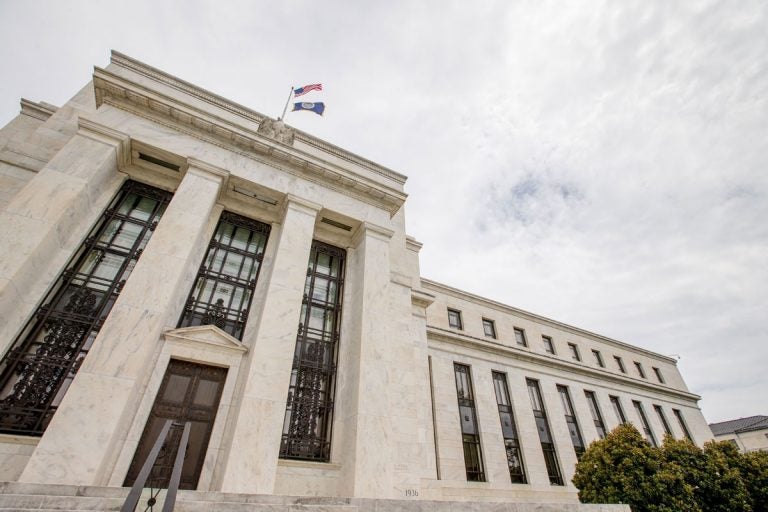Fed keeps key rate steady but notes rising inflation
The Fed is gradually tightening credit to control inflation against the backdrop of a tight job market, a resilient economy and a pickup in consumer prices.

The Marriner S. Eccles Federal Reserve Board Building in Washington. (Andrew Harnik/AP Photo, File)
The Federal Reserve kept its benchmark interest rate unchanged Wednesday but noted that inflation is nearing its 2 percent target rate after years of remaining undesirably low.
The Fed ended its latest policy meeting by leaving its key short-term rate unchanged at 1.5 percent to 1.75 percent, the level it set in March after its sixth rate increase since December 2015. The Fed is gradually tightening credit to control inflation against the backdrop of a tight job market, a resilient economy and a pickup in consumer prices.
In a statement, the central bank said it expects “further gradual increases” in rates and says recent data show it’s edging close to achieving its annual 2 percent target for annual inflation.
“Inflation on a 12-month basis is expected to run near the committee’s symmetric 2 percent objective over the medium term,” the Fed said.
The use of “symmetric” suggests that Fed officials might be willing to let inflation run slightly above its 2 percent target for some time, given that inflation has run below the target for six years.
Analysts said the Fed’s statement Wednesday made it even clearer that it intends to resume raising rates at its next meeting in mid-June. And some Fed watchers said they interpreted the statement to suggest that the central bank foresees four hikes for 2018, up from the three it predicted in March.
Ben Ayers, senior economist at Nationwide, said he was increasing his forecast from three rate increases this year to four in the belief that the Fed will follow its hike in March with increases in June, September and December.
“With improved GDP growth expected over the rest of 2018, further declines in unemployment and inflation readings likely to trend higher, we expect the Fed to continue on its path of tightening monetary policy at roughly a 25 basis point increase per quarter through the end of 2019,” Ayers said.
The Fed’s statement noted that the U.S. job market has continued to strengthen along with a steady economy, now into its ninth year of expansion since the Great Recession ended.
“Job gains have been strong, on average, in recent months and the unemployment rate has stayed low,” the statement said.
It did observe that household spending has slowed from a robust pace in the final months of 2017 and held back growth in the January-March quarter. But most economists expect a solid rebound, with the economy expanding at a 3 percent annual rate or better, in the current April-June quarter.
The Fed’s decision Wednesday, which had been expected, came on an 8-0 vote. It was Jerome Powell’s second meeting as chairman since succeeding Janet Yellen earlier this year. Powell in the past has signaled support for the gradual pace of rate hikes that Yellen oversaw.
At a news conference after the Fed’s meeting in March, Powell had said, “We’re trying to take the middle ground, and the committee continues to believe that the middle ground consists of further gradual increases in the federal-funds rate.”
Bond investors are signaling that they expect a pickup in U.S. inflation, having bid up the yield on the 10-year Treasury note last week above 3 percent before the yield settled just below that. A year ago, the 10-year yield was just 2.3 percent.
The central bank is meeting as its board is undergoing a makeover, with a raft of new Trump appointees who appear generally supportive of the Fed’s cautious approach to rates since the Great Recession ended.
Despite Trump’s complaints during the presidential race that the Fed was aiding Democrats in keeping rates ultra-low under President Barack Obama, his choices for a chairman and for other board positions have been moderates rather than hard-core conservatives who would favor a faster tightening of credit.
Under Powell’s predecessors, Yellen and Ben Bernanke, the board endured criticism from some Republicans over its decision to pursue a bond purchase program designed to cut long-term borrowing rates and to leave its key rate at a record low near zero for seven years. The critics charged that those policies would eventually produce destructive bubbles in the prices of stocks and other assets and, eventually, undesirably high inflation.
Since the Fed began raising rates in December 2015, the pace has been modest and gradual: One quarter-point rate increase in 2015, one in 2016, three in 2017 and one so far this year. Even now, the Fed’s benchmark short-term rate, which influences consumer and business loan rates throughout the economy, remains in a low range.
Trump has announced the nomination of Richard Clarida, a Columbia University economist and expert on monetary policy, as the Fed’s vice chairman. That choice was seen as providing specialized expertise for Powell, who is not an economist.
The president also nominated Michelle Bowman, the Kansas state bank commissioner, for a Fed board slot that is normally reserved for a community banker. Earlier, Trump chose Randal Quarles, an investment banker, as vice chairman for bank supervision, and Marvin Goodfriend, an economist at Carnegie Mellon University, for another vacant board seat.
The nominations generally match mainstream views on the Fed’s proper role in managing rates. One exception is Goodfriend, who has favored changes pushed by conservatives to limit the Fed’s flexibility in rate decisions. Goodfriend’s nomination squeaked out of a Senate committee on a 13-12 vote, with all Democrats opposed, indicating he could face difficulty winning confirmation by the full Senate.
WHYY is your source for fact-based, in-depth journalism and information. As a nonprofit organization, we rely on financial support from readers like you. Please give today.




